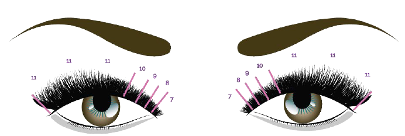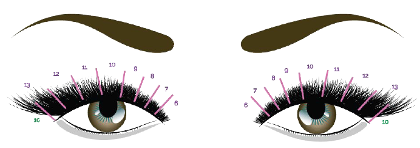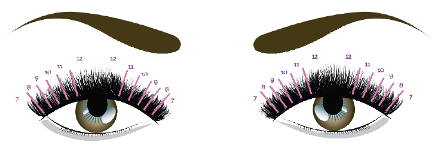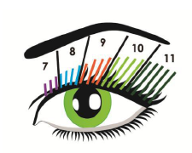3.4 Eye shapes and lash styles
The size, shape and direction of our eyes can have a massive impact on the way our lash extensions will look. Some lash styles will look better on certain eye shapes, and if the incorrect style is chosen, the lash extensions can actually make a client’s eyes look droopy!
Overview of eye shapes
When we start to look at the wide range of eye shapes you will work with, you will need to consider three distinct categories – physical shape, dimension and anatomy. The diagram below provides a good visual representation of these categories:

All of us will have features from the categories above. You may have a client who has small, almond and downturned eyes, and then your next client might have average almond eyes, which are hooded! The first distinction will always be between round and almond:

As you can see from the comparison above, round eyes tend more circular, and the height in the centre is larger, whereas almond eyes have a more distinct taper on each end – much like the shape of almonds! Oval shaped eyes are somewhere in the middle of round and almond. From there, we can determine the size of the eyes. If your clients’ eyes are a similar size to their mouth and nose, then they are average; if they are smaller or bigger than the mouth and nose, then they can be categorised as small or big.
Once you have determined the physical shape and the dimension, the next step is to look closer at the anatomy of each eye shape. Let’s take a look at each in more detail:
Wide-set
A person with wide-set eyes will have a space between their eyes that is more than the width of their eyeball.

Deep-set
As the name suggests, deep-set eyes are set deeper into the skill and will usually make the brown bone appear more prominent.

Close-set
In contrast to wide-set eyes, a person with close-set eyes will have a smaller gap between their eyes, usually a smaller width than their eyeball.

Protruding
Protruding eyes project outward in the eye socket area and are usually larger and round in shape.

Hooded
Hooded eyes are where the eyelid appears smaller, and there is usually an extra layer of skin that is over the crease. The skin may droop down and give the appearance that there is no visible eyelid.

Monolid
On the surface, monolid eyes are flat and will have little to no crease. These types of lids are common amongst Asian clients.

Downturned
Downturned eyes can be determined by a slight drop in the outer corners.

Upturned
Upturned eyes can be determined by a natural lift in the outer corners.

The eye shapes explained are very broad categories, and you and your clients may have features of a few!
If you are interested in learning more about eye shapes and types, read the articles linked:
Lash styles
Lash styling is a critical skill for all technicians to have, and knowing which lash styles that will suit varying eye shapes is absolutely essential! There are a range of styles that are currently on trend, with new styles emerging all the time.
Natural

As the name suggests, the natural lash style is for clients who want a natural look. This is considered the universal style and will suit most eye shapes.
Cat eye

The cat eye lash style is a perfect way to elongate eyes, especially for clients who have a rounder shaped eye or who have smaller eyes. The prominence of the lashes in this style is focussed on the outer corners of the eyes and is achieved by gradually increasing the length of the lash extensions.
Doll

This lash style is an excellent way to open up the eyes of clients with smaller eyes. This look is achieved by having the longest lashes on the centre of the lash line, with the length decreasing toward each corner.
Glam

This lash style is similar to the natural lash and is suitable for most eye shapes. The main difference is the tapering toward the outer corners of the eye and the overall placement of the lashes to create more volume.
Hepburn

The Hepburn look uses a similar approach to the cat-eye, except the tapering toward the outer corners is less dramatic. This style suits clients’ with almond eyes.
Monroe

This look is very similar to a Hepburn set but is slightly adjusted for clients who cannot take the length at the outer corner. As you can see in the diagram, this style starts with shorter lengths graduating to longer along the lash line with a decrease in the outer corner.
The impact of eye shapes on eyelash extensions
Now that you have a better understanding of the wide range of eye shapes, we can now delve deeper into how this will impact your lash selection. Certain curl types and lash styles will look better on different eye shapes, and as a lash technician, it is essential that you know the differences! Part of your role will be to try and achieve the clients desired look while working within the parameters you have – their natural eye shape.
To learn more about matching the correct style to the eye shape, watch the videos linked:
As you learned in the videos, there are certain styles that will work better on certain eye shapes. Your aim is to make the eyes open and not droopy! You need to be strategic with your lash placement and choice of style because it will be the difference between ‘lashes on fleek’ and ‘lashes eek’! Using the most common eye shapes as our starting point, the table provides a quick reference guide for you:
| Lash style | Curl considerations | Best eye shapes |
| Natural | For natural styling, any curls can be used, taking into consideration the eye shape of the client. | Universal styles for all eye shapes |
| Cat eye | C, CC or D curls can be used are best for achieving the cat eye look. For some clients, you may also use B curl towards the outer corner while reducing the length by 1mm to give the flick effect. | Protruding, downturned, hooded, upturned, round and monolid eyes. |
| Doll | C, D, CC, L and L+ can be used for a lifting effect. | Hooded eyes, wide-set eyes and small eyes. |
| Glam | Any curl type would go well with glam lashes, but the eye shape should be taken into consideration | Will suit most eye shapes. |
If you would like to learn more about which lash styles and selecting the right lashes for your client’s eye shape, read the articles linked:
Lash styles are always evolving, and it is important that you are up-to-date with all of the latest trends. In recent years, the ‘liner effect’ and the ‘ Kimmy K’ look have increased in popularity. To achieve a broad range of lash styles, it all comes down to perfecting your application techniques. It is a true balance of selecting the right lash in terms of length, curl, and diameter and then placing each lash to compliment your clients’ natural shape or to combat your clients’ natural shape to achieve the desired look. Now that you understand all of the variables that you need to consider when selecting the perfect lashes and styles for your clients, we can now move onto the different lash application techniques you will use.